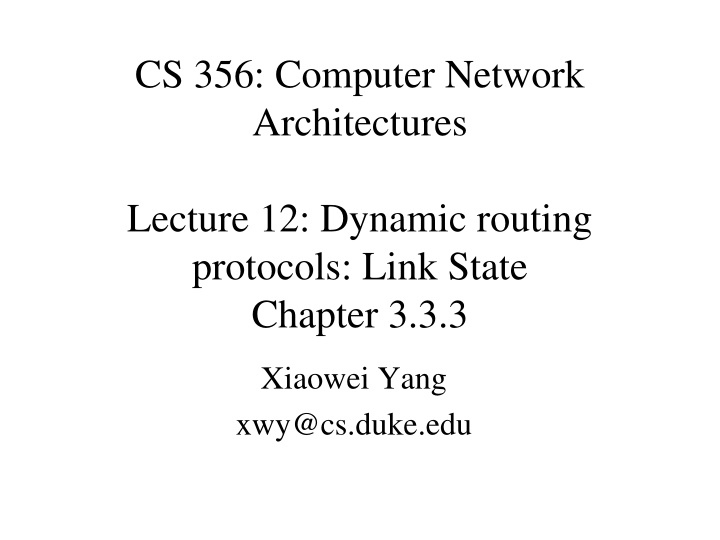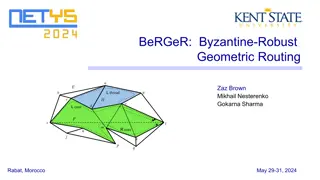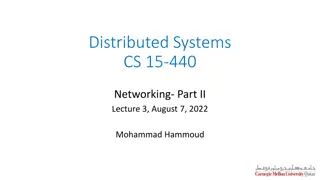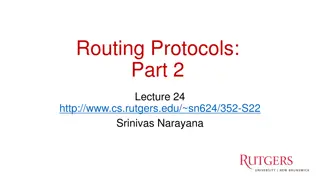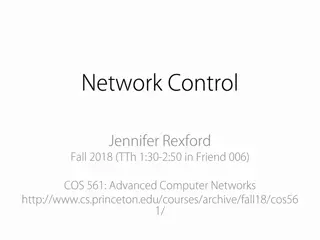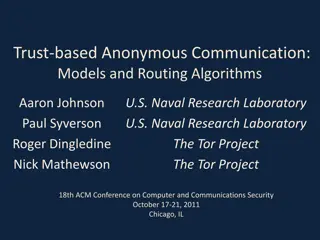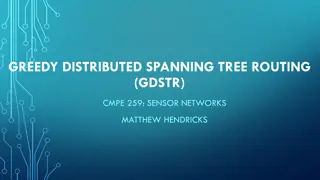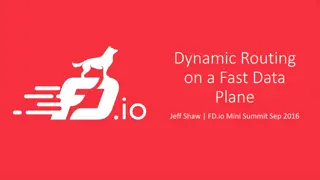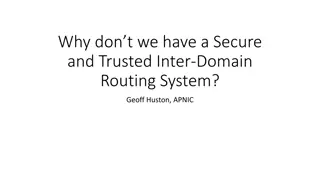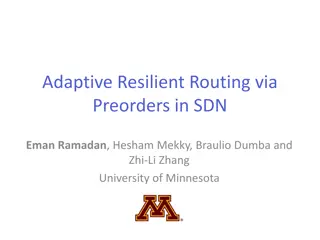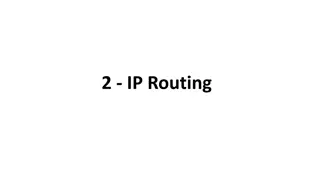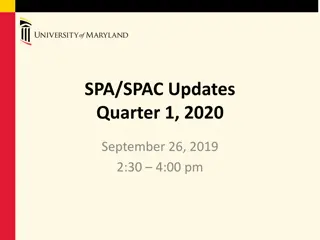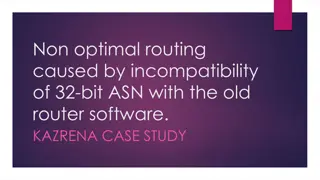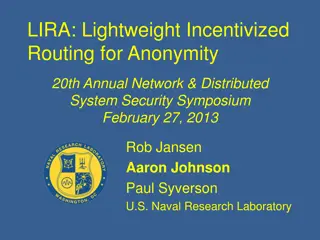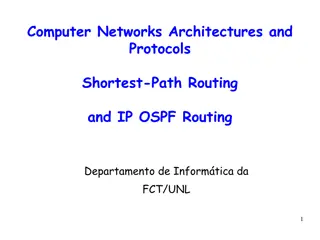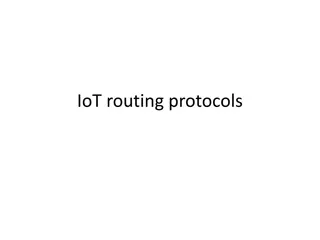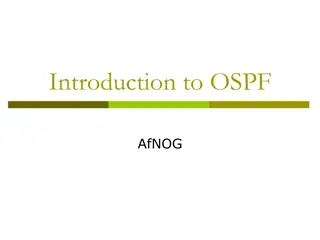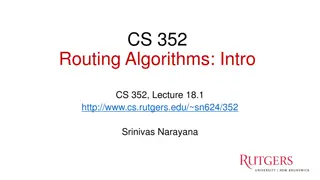Dynamic Routing Protocols & Algorithms Overview
Today's lecture covers dynamic routing protocols in computer network architectures, focusing on link-state protocol like OSPF, distributed routing algorithms, and common routing protocols such as RIP, IGRP, OSPF, IS-IS, BGP, and their working mechanisms.
Download Presentation

Please find below an Image/Link to download the presentation.
The content on the website is provided AS IS for your information and personal use only. It may not be sold, licensed, or shared on other websites without obtaining consent from the author.If you encounter any issues during the download, it is possible that the publisher has removed the file from their server.
You are allowed to download the files provided on this website for personal or commercial use, subject to the condition that they are used lawfully. All files are the property of their respective owners.
The content on the website is provided AS IS for your information and personal use only. It may not be sold, licensed, or shared on other websites without obtaining consent from the author.
E N D
Presentation Transcript
CS 356: Computer Network Architectures Lecture 12: Dynamic routing protocols: Link State Chapter 3.3.3 Xiaowei Yang xwy@cs.duke.edu
Today Routing information protocol (RIP) Link-state routing Algorithm Protocol: Open shortest path first (OSPF)
Dynamic Routing There are two parts related to IP packet handling: 1. Forwarding (per-node operation): how to pass a packet from an input interface to the output interface of a router 2. Routing (distributed algorithm): how to find and setup a route ? Implemented by dynamic routing protocols
What distributed routing algorithms common routing protocols use Routing protocol Distributed algorithm Routing information protocol (RIP) Distance vector Interior Gateway routing protocol (IGRP, cisco proprietary) Open shortest path first (OSPF) Intermediate System-to-Intermediate System (IS-IS) Border gateway protocol (BGP) Distance vector Link state Link state Path vector
Distance vector algorithm: initialization Let Dx(y) be the estimate of least cost from x to y Initialization: Each node x knows the cost to each neighbor: c(x,v). For each neighbor v of x, Dx(v) = c(x,v) Dx(y) to other nodes are initialized as infinity Each node x maintains a distance vector (DV): Dx = [Dx(y): y N ]
Distance vector algorithm: updates Each node x sends its distance vector to its neighbors, either periodically, or triggered by a change in its DV When a node x receives a new DV estimate from a neighbor v, it updates its own DV using the B-F equation: If c(x,v) + Dv(y) < Dx(y) then Dx(y) = c(x,v) + Dv(y) Sets the next hop to reach the destination y to the neighbor v Notify neighbors of the change The estimate Dx(y) will converge to the actual least cost dx(y)
RIP - Routing Information Protocol A simple intradomain protocol Straightforward implementation of Distance Vector Routing Each router advertises its distance vector every 30 seconds (or whenever its routing table changes) to all of its neighbors RIP always uses 1 as link metric Maximum hop count is 15, with 16 equal to Routes are timeout (set to 16) after 3 minutes if they are not updated
RIP - History Late 1960s : Distance Vector protocols were used in the ARPANET Mid-1970s: XNS (Xerox Network system) routing protocol is the ancestor of RIP in IP (and Novell s IPX RIP and Apple s routing protocol) 1982 Release of routed for BSD Unix 1988 RIPv1 (RFC 1058) - classful routing 1993 RIPv2 (RFC 1388) - adds subnet masks with each route entry - allows classless routing 1998 Current version of RIPv2 (RFC 2453)
RIPv1 Packet Format RIP Message IP header UDP header 1: RIPv1 1: request 2: response Command Version Set to 00...0 2: for IP address family Set to 00.00 one route entry 32-bit address (20 bytes) Unused (Set to 00...0) Address of destination Unused (Set to 00...0) metric (1-16) Cost (measured in hops) Up to 24 more routes (each 20 bytes) One RIP message can have up to 25 route entries 32 bits
RIPv2 RIPv2 is an extends RIPv1: Subnet masks are carried in the route information Authentication of routing messages Route information carries next-hop address Uses IP multicasting to send routing messages Extensions of RIPv2 are carried in unused fields of RIPv1 messages
RIPv2 Packet Format RIP Message IP header UDP header 2: RIPv2 1: request 2: response Command Version Set to 00...0 2: for IP address family Set to 00.00 one route entry 32-bit address (20 bytes) Unused (Set to 00...0) Address of destination Unused (Set to 00...0) metric (1-16) Cost (measured in hops) Up to 24 more routes (each 20 bytes) One RIP message can have up to 25 route entries 32 bits
RIPv2 Packet Format RIPv2 Message IP header UDP header 2: RIPv2 Used to provide a method of separating "internal" RIP routes (routes for networks within the RIP routing domain) from "external" RIP routes Command Version Set to 00.00 address family route tag one route entry IP address (20 bytes) Subnet mask for IP address Subnet Mask Next-Hop IP address Identifies a better next-hop address on the same subnet than the advertising router, if one exists (otherwise 0 .0) metric (1-16) Up to 24 more routes (each 20 bytes) 32 bits
RIP Messages This is the operation of RIP in routed. Dedicated port for RIP is UDP port 520. Two types of messages: Request messages used to ask neighboring nodes for an update Response messages contains an update
Routing with RIP Initialization: Send a request packet (command = 1, address family=0..0) on all interfaces: RIPv1 uses broadcast if possible, RIPv2 uses multicast address 224.0.0.9, if possible requesting routing tables from neighboring routers Request received: Routers that receive above request send their entire routing table Response received: Update the routing table Regular routing updates: Every 30 seconds, send all or part of the routing tables to every neighbor in an response message Triggered Updates: Whenever the metric for a route changes, send entire routing table.
RIP Security Issue: Sending bogus routing updates to a router RIPv1: No protection RIPv2: Simple authentication scheme RIPv2 Message IP header UDP header 2: plaintext password Command Version Set to 00.00 0xffff Authentication Type Authetication Password (Bytes 0 - 3) Password (Bytes 4 - 7) Password (Bytes 8- 11) Password (Bytes 12 - 15) Up to 24 more routes (each 20 bytes) 32 bits
RIP Problems RIP takes a long time to stabilize Even for a small network, it takes several minutes until the routing tables have settled after a change RIP has all the problems of distance vector algorithms, e.g., count-to-Infinity RIP uses split horizon to avoid count-to-infinity The maximum path in RIP is 15 hops
Link-state routing aims to address those problems
Distance Vector vs. Link State Routing With distance vector routing, each node has information only about the next hop to a destination Node A: to reach F go to B Node B: to reach F go to D Node D: to reach F go to E Node E: go directly to F A B C Distance vector routing makes poor routing decisions if directions are not completely correct (e.g., because a node is down). Count to infinity F D E If parts of the directions incorrect, the routing may be incorrect until the routing algorithms has re-converged.
Distance Vector vs. Link State Routing In link state routing, each node has a complete map of the topology A B C A B C A B C F F F D E D E D E A B C If a node fails, each node can calculate the new route F D E Challenge: All nodes need to have a consistent view of the network A B C A B C A B C F D E F F D E D E 19
Link State Routing: Basic operations 1. Each router establishes a relationship ( adjacency ) with its neighbors 2. Each router generates a link state advertisement (LSA) which is reliably flooded to all routers ID of the node that creates the LSP List of neighbors and costs of the links A sequence number TTL 3. Each router maintains a database of all received LSAs (topological database or link state database), which describes the network has a graph with weighted edges 4. Each router uses its link state database to run a shortest path algorithm (Dijkstra s algorithm) to produce the shortest path to each network 20
Link state routing: graphical illustration 1 b 3 2 a c d 6 Collecting all pieces yield a complete view of the network! a s view b 3 6 a c d s view b s view 3 1 2 b c d a c 1 b c s view a c d 21 6
Operation of a Link State Routing protocol Dijkstra s Received LSPs Link State Database IP Routing Table Algorithm LSPs are flooded to other interfaces 22
Reliable flooding We ve learned a flooding algorithm used by Ethernet switches Question: why is it insufficient for link-state routing? Lost LSAs may result in inconsistent topologies at different routers Inconsistent topologies may lead to routing loops
Reliable flooding LSPs are transmitted reliably between adjacent routers ACK and retransmission For a node x, if it receives an LSA sent by y Stores LSA(y) if it does not have a copy Otherwise, compares SeqNo. If newer, store; otherwise discard If a new LSA(y), floods LSA(y) to all neighbors except the incoming neighbor
When to flood an LSP Triggered if a link s state has changed Detecting failure Neighbors exchange hello messages If not receiving hello, assume dead Periodic generating a new LSA Fault tolerance (what if LSA in memory is corrupted?
Path computation Dijkstra s Shortest Path Algorithm for a Graph Input:Graph(N,E) with cvw s Output: Dn N the set of nodes and E the set of edges link cost (cvw = if (v,w) E, cvv = 0) source node. cost of the least-cost path from node s to node n M = {s}; for each n M Dn = csn; while (M all nodes) do Find w M for which Dw = min{Dj ; j M}; Add w to M; for each neighbor n of w and n M Dn = min[ Dn, Dw + cwn ]; Update route; enddo
Practical Implementation: forward search algorithm More efficient: extracting min from a smaller set rather than the entire graph Two lists: Tentative and Confirmed Each entry: (destination, cost, nextHop) 1. Confirmed = {(s,0,s)} 2. Let Next = Confirmed.last 3. For each Nbr of Next Cost = my Next + Next Nbr If Neighbor not in Confirmed or Tentative Add (Nbr, Cost, my.Nexthop(Next)) to Tentative If Nbr is in Tentative, and Cost is less than Nbr.Cost, update Nbr.Cost to Cost 4. If Tentative not empty, pick the entry with smallest cost in Tentative and move it to Confirmed, and return to Step 2 Pick the smallest cost from a smaller list Tentative, rather than the rest of the graph
Step Confirmed Tentative 1 (D,0,-) 2 3 4 5 6 7
Step Confirmed Tentative 1 (D,0,-) 2 (D,0,-) (B,11,B), (C,2,C) 3 (D,0,-), (C,2,C) (B,11,B) 4 (D,0,-), (C,2,C) (B,5,C) (A,12,C) (A,12,C) 5 (D,0,-), (C,2,C), (B,5,C) 6 (D,0,-),(C,2,C),(B,5,C) (A,10,C) 7 (D,0,-),(C,2,C),(B,5,C), (A,10,C)
OSPF OSPF = Open Shortest Path First Open stands for open, non-proprietary A link state routing protocol The complexity of OSPF is significant RIP (RFC 2453 ~ 40 pages) OSPF (RFC 2328 ~ 250 pages) History: 1989: RFC 1131 OSPF Version 1 1991: RFC1247 OSPF Version 2 1994: RFC 1583 OSPF Version 2 (revised) 1997: RFC 2178 OSPF Version 2 (revised) 1998: RFC 2328 OSPF Version 2 (current version)
Features of OSPF Provides authentication of routing messages Similar to RIP 2 Allows hierarchical routing Divide a domain into sub-areas Enables load balancing by allowing traffic to be split evenly across routes with equal cost
OSPF Packet Format OSPF Message IP header OSPF Message Header Body of OSPF Message OSPF packets are not carried as UDP payload! OSPF has its own IP protocol number: 89 ... ... Message Type Specific Data LSA LSA LSA TTL: set to 1 (in most cases) LSA Header LSA Data Destination IP: neighbor s IP address or 224.0.0.5 (ALLSPFRouters) or 224.0.0.6 (AllDRouters) Link state advertisement
OSPF Common header OSPF Message Header Body of OSPF Message 2: current version is OSPF V2 version type message length ID of the Area from which the packet originated Message types: 1: Hello (tests reachability) 2: Database description 3: Link Status request 4: Link state update 5: Link state acknowledgement source router IP address Area ID 0: no authentication 1: Cleartext password 2: MD5 checksum (added to end packet) checksum authentication type authentication authentication Standard IP checksum taken over entire packet 32 bits Authentication passwd = 1: 64 cleartext password Authentication passwd = 2: 0x0000 (16 bits) KeyID (8 bits) Length of MD5 checksum (8 bits) Nondecreasing sequence number (32 bits) Prevents replay attacks
OSPF LSA Format LSA Link Age Link Type Link State ID LSA Header advertising router LSA Header LSA Data link state sequence number checksum length Link ID Link 1 LSAs Type 1: cost of links between routers Type 2: networks to which the router connects Others: hierarchical routing Link Data Link Type Metric #TOS metrics Link ID Link Data Link 2 Link Type Metric #TOS metrics
Type 1 LSA Link state ID and Advertising router are the same, 32-bit router ID Link ID: router ID at the other end of the link Link Data: identify parallel links Metric: cost of the link Type: types of the link e.g., point-to-point
Open question How to set link metrics? Design choice 1: all to 1 Design choice 2: based on load Problems? In practice: static
Hierarchical OSPF Two-level hierarchy: local area, backbone. Link-state advertisements only in area Each nodes has detailed area topology; only know direction (shortest path) to nets in other areas. Area border routers: summarize distances to nets in own area, advertise to other Area Border routers. Backbone routers: run OSPF routing limited to backbone. 39
Scalability and Optimal Routing A frequent tradeoff in network design Hierarchy introduces information hiding ABR
OSPF summary A link-state routing protocol Each node has a map of the network and uses Dijkstra to compute shortest paths Nodes use reliable flooding to keep an identical copy of the network map
Summary Routing information protocol (RIP) Link-state routing Algorithm Protocol: Open shortest path first (OSPF)
